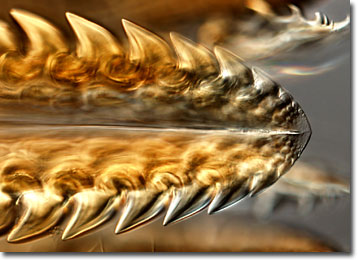Differential Interference Contrast Image Gallery
Deer Tick (Ixodes dammini)
Though extremely small in size, the deer tick may cause a considerable amount of trouble. As the primary vector of Lyme disease in North America, the possibility of being bitten by a deer tick is a tremendous concern for those who spend time outdoors, especially in the northeastern United States, where they are most prevalent.

Deer ticks have a complex, two-year lifecycle that consists of several stages. Eggs are generally deposited in the spring and tiny larvae emerge several weeks later. The larvae attach to small mammals, such as field mice, and feed before falling to the ground and overwintering. The following spring, the larvae molt into nymphs that feed on mice or larger mammals during the summer. It is in this stage that deer ticks are most likely to bite humans. After their blood meal, the nymphs molt again, achieving their adult form in the fall. Adult ticks normally attach themselves to white-tailed deer, or other large mammals, to mate. Afterwards, males fall from the host and die, while females feed once more in order to successfully produce eggs.
In recent years, as deer populations have risen and humans have increasingly encroached upon their lands, the interaction between the species has become more common. Thus, humans have also had more contact with the deer tick and its frequent companion, the Lyme disease spirochete Borrelia burgdorferi. In fact, according to the Centers for Disease Control, more than 16,000 cases of Lyme disease are reported each year. Initial signs of the infection include a characteristic bulls-eye rash and flu-like symptoms, but may progress into debilitating arthritis and neurological malfunctions if left untreated.
